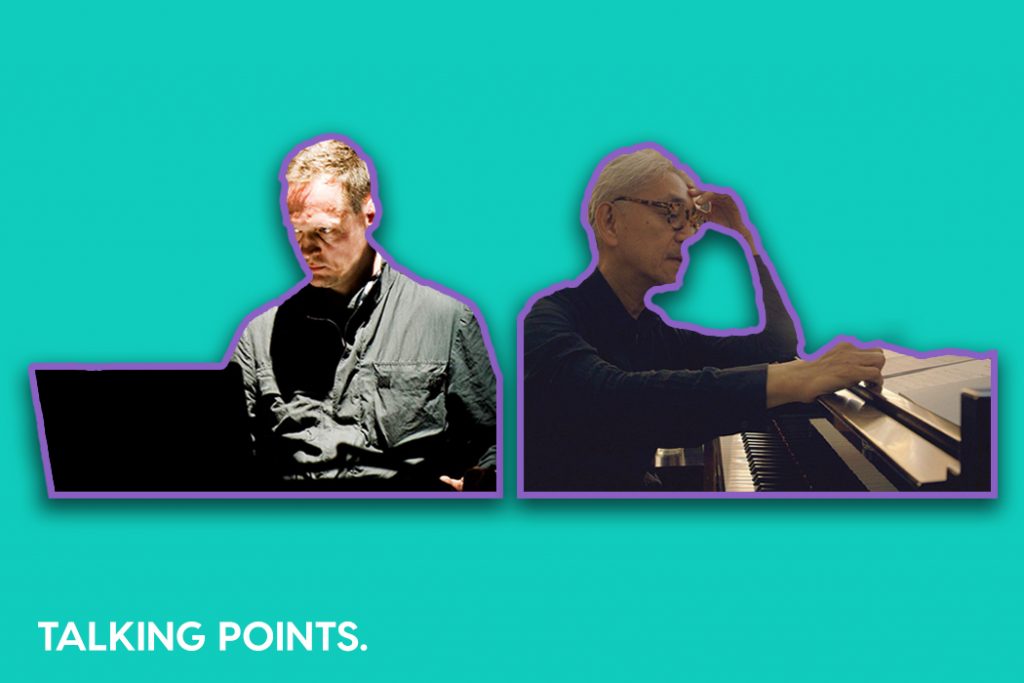
Welcome to our brand new column, Talking Points, where in each post, we revisit a lengthy lecture or Q&A with the greatest minds in music production and composition, and elucidate the most interesting details or concepts mentioned by each guest in order to gain a fresh perspective on the topic in question. In other words, we’ll extrapolate the talking points. Follow along with the series here, or sign up for our newsletter to get more music learning like this in your inbox.
Today on Talking Points, we revisit a conversation between the world-renowned composer Ryuichi Sakamoto, electronic music and installation artist Carsten Nicolai (a.k.a. Alva Noto), and Berlinale moderator Peter Cowie. Sakamoto and Nicolai recently released an exquisite live recording from their collaborative performance at the Glass House, entitled Glass, and Sakamoto’s new biographical documentary CODA is now playing in select theaters.
In this talk, the pair cover topics like their working collaboration and methods, improvising and being open to following the musical moment, and of course, scoring films. But, as usual, this talk runs pretty long, so we’ll do you a solid and pluck out the most interesting and noteworthy things they say, for some consolidated advice.
01) Pure improvisation often leads to pure innovation.
The two artists talk a lot about just showing up and playing. And in this simple concept perhaps lies one of the greatest feats of musicality in existence: the ability to truly and wholly listen before reacting sonically.
Improvising is what led the pair to achieve the patient, blissful, place-specific music of their Glass House recording, as they started their performance with a mic capturing the rain storm outside, playing with the rain and letting the weather dictate their gestures to follow. When the rain subsided, the music rushed up to the forefront to fill the space. Sakamoto eventually began rubbing the glass walls, exploring the sonic imprint of the space both architecturally and structurally in one move. All of this is just to say that when you leave yourself open to the variables of each space and performance situation, you’ll never be without newness at your side, and the music you make will never feel stale.
02) Worlds meet where you least expect them to.
Nicolai mentions that he had a hard time envisioning, at first, how his electronic textures and synthesized sounds would fit into the imaginary world of The Revenant, a Western that takes place in the early 19th century. He said that kind of sound design typically accompanies sci-fi films. At first, Sakamoto had a few demos for the film that were made electronically. Eventually, the full orchestra was brought in to record some of the cues, and the film just didn’t feel the same anymore. The filmmaker, Alejandro Iñárritu, inevitably requested they bring back those electronic elements, perhaps to help create the lush, colorful vibrancy of the landscape appearing in the film.
So often, what doesn’t seem to make any sense on paper, ends up communicating something much more truthfully. Never stop experimenting and asking questions.
This is a great time to mention that Soundfly is currently hard at work developing our own Mainstage course in film score composition, due to launch later this year. If you’re interested in being notified when the course launches, just sign up for our mailing list and you’ll be the first to know. In the meantime, we have loads of other online courses that might suit your interests, as well as a team of Soundfly Mentors experienced in composition and arranging you can work with before the course is launched!
03) Be in the right place at the right time.
When Sakamoto met Bernardo Bertolucci in Cannes in 1983, he had no idea that the scores he’d eventually write for the Italian filmmaker would help produce some of the most beloved music of Sakamoto’s career. Nor could he expect how demanding Bertolucci was as a collaborator, with requests like, “can you fly to Beijing next week?” — leaving Sakamoto to choose whether to say no, or cancel his performances and recordings and just do it.
We’ll never know if deciding to go was the right or wrong decision, but that moment helped pave the way for a brilliant, fruitful future in music and film for Sakamoto. So perhaps the lesson here is to follow your instinct, and try to think three-dimensionally about your musical priorities at any given moment. Say yes to opportunities that may sound crazy at first, because that’s how you keep challenging yourself! When your moment has come, it will present itself to you.
04) 1+1=3
Sakamoto responds to a question about the use of music in film as an addition to the image, and how they come together to tell the full story. Previously, he mentions that he thought the music in The Revenant was “too loud,” and that cinematically, it didn’t need to be that loud to make the same point, and it therefor took something away from certain moments in the film that could’ve been stronger. In this way, there’s a delicate balance whereby, just like cooking, a little bit too much of one ingredient will mess up the balance of everything coming together.
But then he says, “I always want to get the result of 1+1=3.” In other words, in film, if the performances are good and the images are striking, you don’t really need music to help you get somewhere. He likes to use music instead to try to take you somewhere else, make something completely different happen in the combination of these two elements. Music is part of the soundscape of the film, it’s a material just like the sounds of what’s happening on the screen, but it’s also separate from the film, and a chance to pull in the direction of fantasy at times.
05) Collaboration and coexistence are the same.
Sakamoto says briefly that he has no issue collaborating with people from different parts of the world and of different ages and experiences. To him, all collaboration is a reminder that we live on a very small planet, and that we’re all inherently different, but we all have something to offer someone else. I really like the simplicity of this idea and sentiment, and I think it echoes something very deep about the nature of working in the arts, which is that all art is about the exchange of ideas and perspectives — whether between a performer and audience, between performers working together, or between composer/writer and interpreter. And of course, this applies across all other creative discipline, outside of performance, as well.
No matter the nature of making artistic work, it’s always a way of reaching out to other people and sharing one’s thoughts, or being open to new ideas and perspectives.
Improve all aspects of your music on Soundfly.
Subscribe to get unlimited access to all of our course content, an invitation to join our members-only Slack community forum, exclusive perks from partner brands, and massive discounts on personalized mentor sessions for guided learning. Learn what you want, whenever you want, with total freedom.




